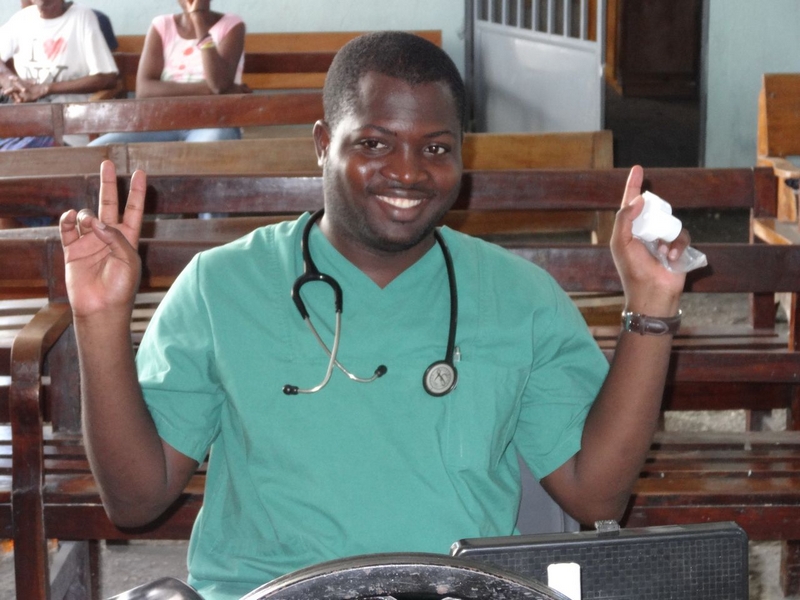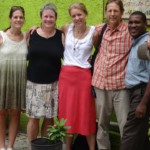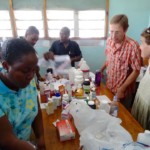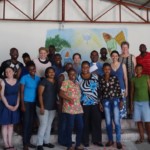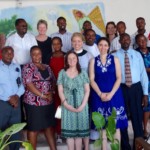4. April, 2014
Emily Smith, Sarah Roeske, Sheryl Stroud Bryant, Matt Mason and Kecia Wharton went down over four days for a medical mission offering check-ups and health care for the school and community. The team of five consisted of four parishioners and Carey Chirico. Additionally, Matt Mason was the first Vestry member to travel
A “school picture” was taken of every child, printed out and distributed to the students. Pictures were then used to create a 2013-2014 yearbook, given to Pere Fanfan in May 2014. Planned craft activity for 400 students which encourages socializing and friendships while keeping children busy during clinic. Crafts also used during community clinic.
Arriving on Thursday afternoon we were welcomed by our priest.
On Friday we helped the 325 children of our school see a doctor and receive appropriate medicine; all received deworming meds. On Saturday we saw about 100 members of the Bolosse community. On Sunday we worshipped with the community and met with the Vestry. It was a wonderful time of shared concerns and productive work. We look forward to taking a vestry member with us soon so that the relationship between our communities can be strengthened that way as well.
This visit we were able to visit two parishioners in their homes which gave us a much clearer vision of where and how our community lives. The church members continue to pray that the restoration of the church will be next on the agenda as the cleared space is a continual reminder of the earthquake and loss.
5. October, 2014
Carey Chirico, Emily Smith, Peter Ozolins, Sarah Roeske and Sheryl Stroud Bryant went down over four days for a medical mission offering check-ups and health care for the school and community.
Planned craft activity for 400 students during clinics on Friday and Saturday.
Peter Ozolins (architect) met with Andrew (architect in Haiti) to discuss ways to implement the sanitary napkin project as well as ways to improve the school infrastructure. Haiti Team (and Pere Fanfan) met with USAID at the US Embassy to discuss grant possibilities to fund the sanitary napkin project. This project came to fruition in 2016 with the funding delivery of a sanitary napkin machine.
6. May, 2015
Carey Chirico, Sarah Roeske, Sheryl Stroud-Bryant, Colleen Scheifelbein and Denise Grim traveled to Hait to conduct the regular clinic for the students of Notre Dame as well as a clinic for the neighborhood of Bolosse. Pictures were taken for the yearbook as well. The team also provided education supplies and support to the school.
One missioner describes the trip:
“The first rooster crow came at 4:17 am and with that the day on our street in Port au Prince, Haiti began. “Pain aller” – “Bread to go” sounds up and down the street. Motorcycles rumble and children’s voices ring out as they wake and get ready for school.
“Across the neighborhood one sound ends- the sound of a hundred or so voices singing – at an all night prayer vigil which held us in our sleep.
“Our trips to Haiti leave me breathless sometimes with the depth and experience of faith lived out in so poor a place. The idea that God is all and that reality is just a transitory thing to be gotten through with love and humor and grace is throughout the community in which we work. This visit is the twelfth for some of us, the tenth for others and the first for others. Over that amount of time we have built deep connections to the community of our Church, school and neighborhood.
“This trip began as they usually do with the Friday morning clinic in our neighborhood of Bolosse, in Port au Prince. Pulling into the gates of the church we see that the doctors and nurses from the Episcopal Haitian community have arrived as well and all are busily setting up small examination areas. Nurses will take vitals, collect measurements and flag issues they spot. Doctors will kneel down and gently talk to each child checking bellies, throats, ears and skin. Many are measured for incipient malnourishment, given asthma meds, and additional iron; all are given de-worming meds and bags of vitamins to take home with them. My usual work area is the Pharmacy which is the last stop of the hour’s long process. Some children, usually the smallest ones, come with parents by the hand but most come alone. The youngest are two and half, babies who cry at the prospect of getting up on the scale. The oldest are about twelve years old and come in with uniforms strategically rolled to look slightly hipper.
“They smile and take their meds carefully, placing them in the brightly decorated lunch bags sent to them by the children and families of St. George’s. This time they also proudly wore brightly colored necklaces made up of cut straw pieces around their necks.
Life at Bolosse
“Bolosse in one of the poorest of the all the urban areas of Port -au-Prince, the Capital of Haiti. And our parish, Our Lady of Ascension is in the heart of it. In addition to the extreme poverty that is remarkable at first view to the city, there were lots of other problems. There is a water problem i,e, not enough clean for use, no potable to drink, too much filthy on the street, unneeded flood with trash that clogs the sewer system. That is just the systemic water problem, to say the least. I will keep the sanitation, malnutrition, health, and housing problems for the next correspondance to focus on the water for the sake of not overloading this email.
“ With the water dilemma, life at Bolosse is next to impossible on a regular day and merely impossible in rainy seasons. This holds true for all inhabitants, and institutions of the region including our parish. In such circumstances, especially after a downpour, coming to Our Lady, walking or driving is a nightmare. In dry season alike, people have to walk in mud, filthy sewage water, and swamp to travel miles to fetch water from a potable water station. That problem exists in all the subdivisions neighboring the capital. That is why we are sometimes obligated to go to look for water without knowing at first the distance and place where we will run across that water.
“In most part of Haiti we don’t have running water. The places that afford their with running water are very few, and they are considered middle class. Yet this water flows on the taps 3 to 4 times a week. And it is unsafe for consumption and other use. The difficulty of having a secure water mills pushed some into violence. Some people went so far to cut or bust the main state sewer by force to capture the water and sell it to their neighbors. Needless to mention the anarchy and chaos that result from these violent act and the weakness of the government in regulating them.
“In this situation, the church became a water distribution center. We are pleased that the church can be a temporary solution. Dozens of people come to get water in our compound. And it is a great delight to see so many brothers and sisters going back and forth into our yard.
While we are doing our best to serve anyone who knocks on our door for this vital indispensable natural drink, but due to our limited capacity it is broke our heart to see some children being turned away with an empty recycling five-gallon bucket not knowing where else to turn to find some water.
Due to political conditions in Haiti, the fall medical trip was cancelled.
7. February, 2016
Bob Miller, Abbey Martinez, Sarah Roeske. Denise Grim and Sheryl Stroud-Bryant traveled to Haiti to conduct the regular clinic for the students of Notre Dame as well as a clinic for the neighborhood of Bolosse. Pictures were taken for the yearbook as well. The team also provided education supplies and support to the school. Bob preached on Sunday and the team met with the vestry of Notre Dame.
A focus group conducted with the women of Notre Dame discussed issues related to the sanitary napkin project. Emily Smith Kimm continued to work on raising money to pay for the machines as well as to figure out the logistics of getting the machines to Port-au-Prince.
